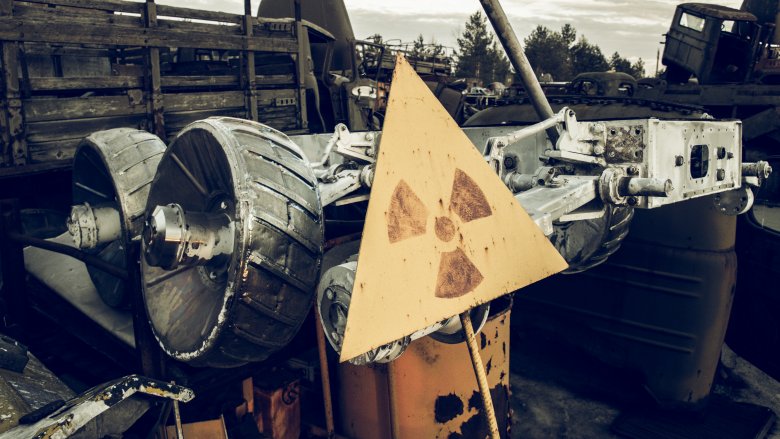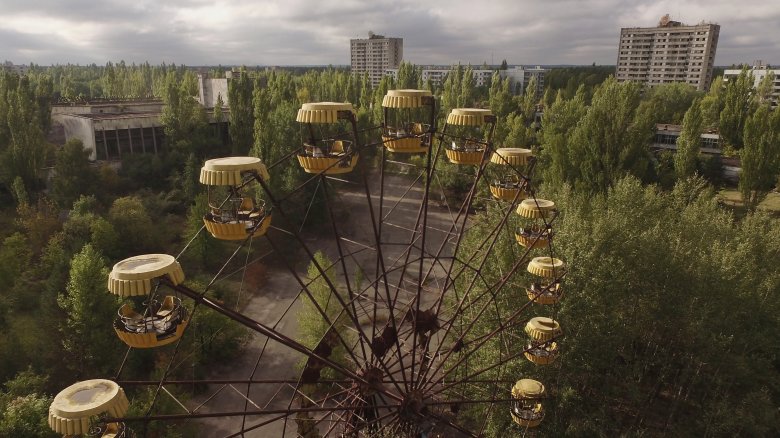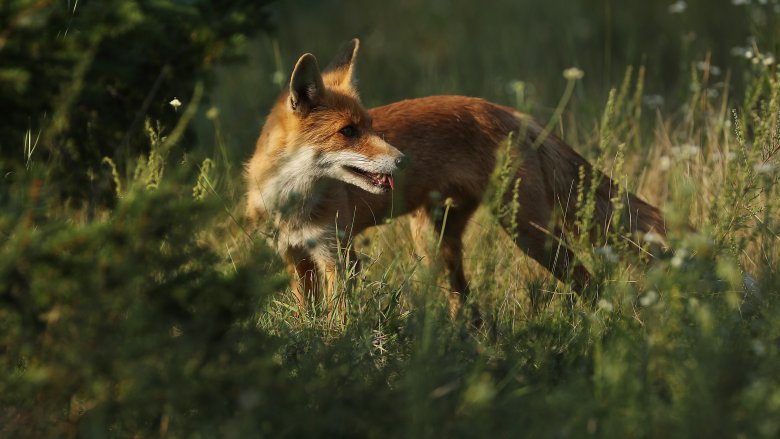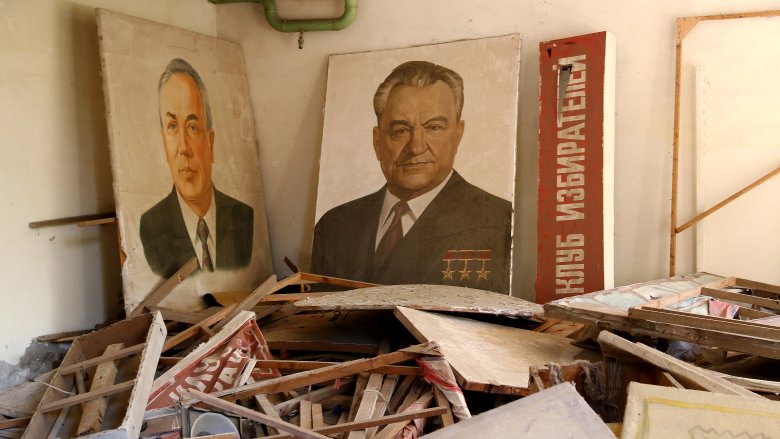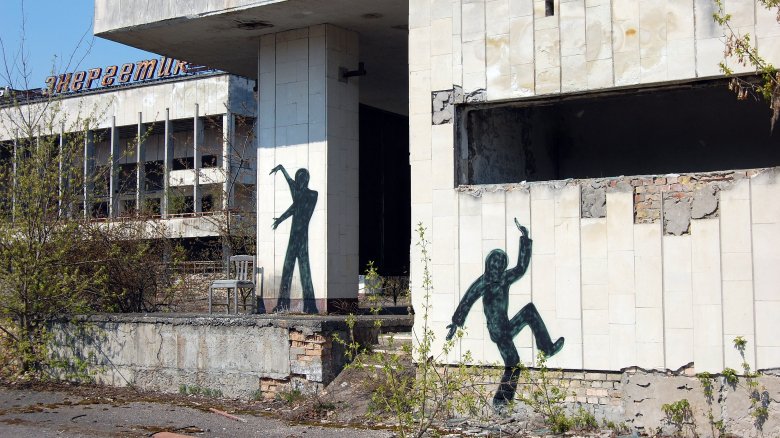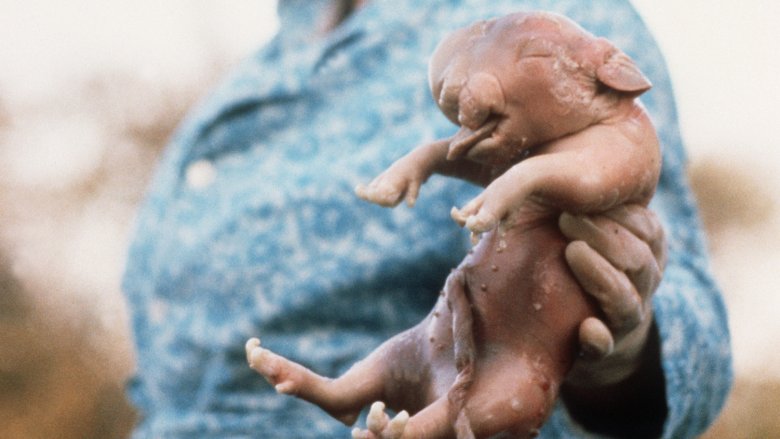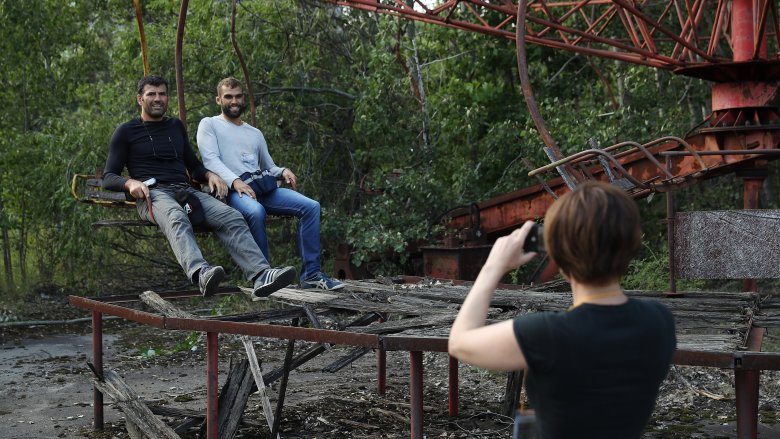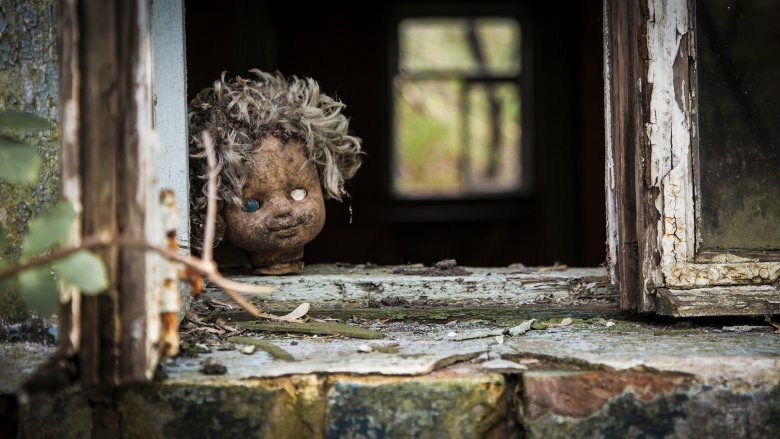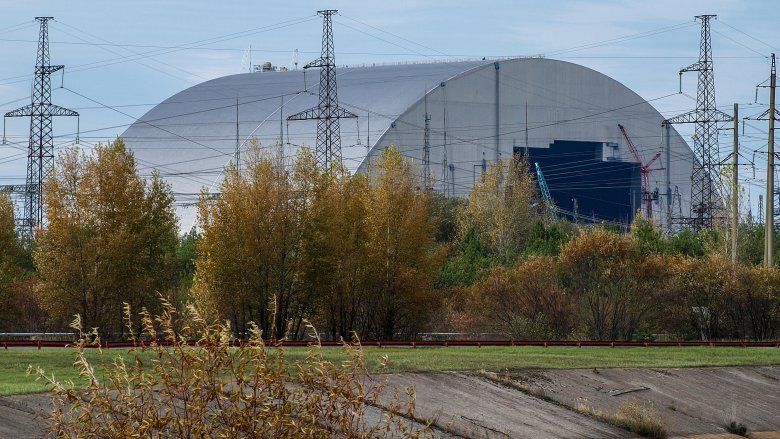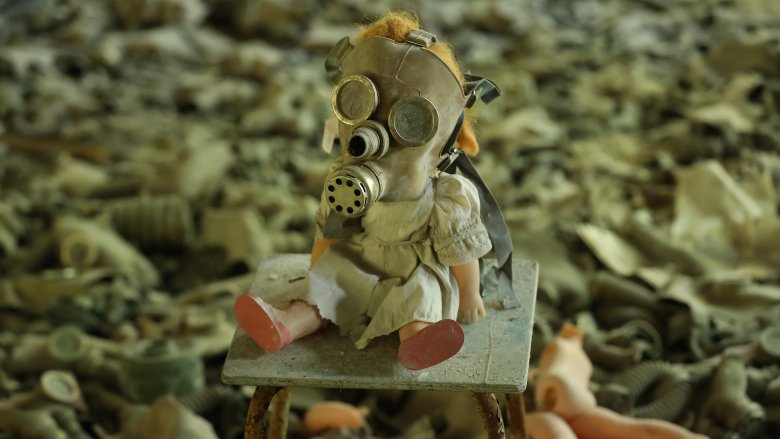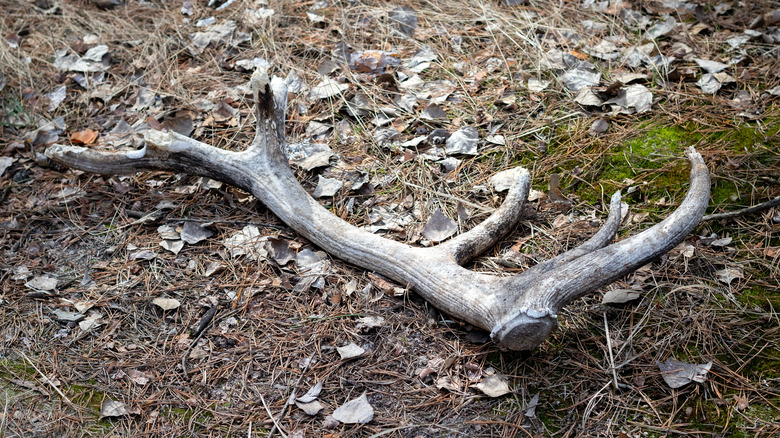The Weirdest Things Ever Found At Chernobyl
The accident at Chernobyl was the worst nuclear disaster of all time (if you only count unintentional nuclear disasters). We'll never really know how high the human toll was because the Soviets weren't exactly forthcoming with numbers, but many scientists believe at least 100,000 deaths can be traced directly back to the 1986 meltdown. But even as the disaster recedes into history, public fascination has picked up speed. Tourism is booming, and images of the ruins are fascinating in a horrific kind of way, sort of like a train wreck ... a super-radioactive train wreck filled with Soviet-era propaganda and a bunch of creepy plastic dolls. And some other pretty weird things, too.
An abandoned carnival
The town of Pripyat was just a mile and a quarter from the doomed power plant — that's where most of the people who worked at Chernobyl lived and raised their families. Today Pripyat is a ghost town, and its prominent, looming feature is the abandoned amusement park (pictured above) that still looks exactly as it did on the day of the disaster, except a million times more creepy. It's almost as if the amusement park was a part of some grand plan to create the most sinister-looking ruins anywhere in the world. What could better symbolize the tragedy of an abandoned town where thousands of children once lived and played than a disintegrating Ferris wheel, a set of bumper cars overgrown with vines, and the skeleton of a merry-go-round?
According to Atlas Obscura, Pripyat's amusement park was supposed to open on May 1 — five days after the disaster at the Chernobyl nuclear plant. But because the townspeople needed something to do while the nuclear reactor was melting down and their homes were slowly filling up with deadly radiation, Soviet officials were kind enough to open the amusement park early, on April 27.
Modern fairground rides sometimes crap out in dangerous ways, killing the people they are intended to entertain, but there's a special kind of horror about a fairground ride that goes swooping in and out of a cloud of radiation. Sort of gives new meaning to the phrase "thrill ride."
Thriving wildlife
If you've ever watched The Simpsons (and we know you have, because duh) then you know that nuclear plus wildlife equals animals with lots of eyes. Funny thing about that, though ... not only do many animals living near Chernobyl not have lots of eyes, they also don't have multiple heads, 12 rows of razor-sharp teeth, or extra kneecaps. In fact according to Slate, the animals that live in the exclusion zone, which is the 1,000-square-mile region around the Chernobyl nuclear plant, mostly don't have any physical abnormalities at all, which actually seems a lot more bizarre than those three-eyed Simpsons creatures we've all imagined must be lurking in the forests around Chernobyl.
You're probably hideously disappointed, so hopefully this fact will comfort you: horrible mutations were much more commonplace back in the early days of the disaster. Researchers found examples of dwarfism, gigantism, and glow-in-the-dark-ism. In plants. Dang. Another crushing disappointment. The boring truth is that mutations in wild animals don't proliferate because most mutated animals don't survive for more than a few days before something takes them out. So if there ever were examples of mutated creatures at Chernobyl, they died before anyone could take note. The Simpsons might have predicted smartwatches and auto-correct with eerie accuracy, but they got the nuclear mutant thing totally wrong.
USSR propaganda
Fifty thousand people lived in Pripyat, and 36 hours after the disaster they were all evacuated from their homes, which in retrospect probably was actually enough time for at least some of them to become three-eyed Simpsons fish. According to The Guardian, townspeople were told that they'd be back home in a day or two, so there was need to pack much more than identity papers and a change of clothes. And while it is true that one day people will be able to live in Pripyat again, Soviet officials were about 23,999 years off the mark, give or take around 363 days.
What is pretty cool about that hasty retreat followed by the never-to-return-again thing is that Pripyat is like a snapshot of Soviet-era Ukraine, if a rapidly decaying, radioactive snapshot, which is what makes the place so fundamentally charming. In a haunting, macabre sort of way.
Soviet propaganda is all over Pripyat — there's a big room full of the reasonably well-preserved portraits of Soviet leaders, a statue of a soldier who looks sternly resilient as the town crumbles all around him, and walls plastered with disintegrating murals designed to helpfully remind the long-since vanished population how awesome it is to live under Soviet rule. Like the Soviet empire itself, everything in Pripyat has fallen apart, and what remains is just a ghostly shadow of something that lives only in history books.
Silhouettes of missing townspeople
Most people try to get away from nuclear disasters. Others think, "Cool, let's break in with a can of spray paint." Graffiti artists said to be from Germany and Belarus must have missed the whole newsflash about deadly radiation, or maybe they thought there was an off chance of obtaining superpowers, like every third or fourth Marvel superhero. Whatever their motivation, graffiti artists did sneak into the exclusion zone, and many left eerily beautiful works of art all over Pripyat and the surrounding areas.
Some of the most striking graffiti is in Pripyat, where artists painted creepy silhouettes of the missing residents. In one room, a little girl with bows in her pigtails reaches for a light switch. Outside, a boy pulls a toy truck toward the corner of a building, as if to peer around it. On other walls, people appear to dance, and in another three children are jumping or maybe floating, holding on to each other in either exuberance or terror. It's probably not an accident that the silhouettes are eerily similar to the "permanent shadows" left on the walls and steps of buildings in Hiroshima after the nuclear attack that ended World War II. Visitors have described the Pripyat silhouettes as ghostly or haunting, and if the photos are anything to go by, the real-life experience of looking at those strange silhouettes must be downright unsettling.
A bunch of old ladies
According to the Telegraph, the Soviet government evacuated 116,000 people after the accident at Chernobyl, eventually resettling most of them in apartments outside the exclusion zone. But some residents of the smaller villages weren't interested in leaving. They'd survived Joseph Stalin and the Nazis, and they weren't about to run away from a danger they couldn't even see. Some returned to their homes within a few years, while others only waited a few months. The government objected, but what could they do? Have you ever tried to give orders to a grandmother?
About 1,200 people, known as "self-settlers," moved back into the exclusion zone in the months and years following the disaster. Most of them were over the age of 48, and of the handful that still survive today about 80 percent are female.
It's not like the self-settlers don't understand the risk — these grandmas have had it mansplained to them in about a million different ways. They know the soil is contaminated, but they grow food in it anyway. They raise chickens and hogs, despite the real dangers of eating meat that's been raised in the exclusion zone. Many of them are in their 70s or 80s, and they're still mostly healthy — so that's all the anecdotal evidence they need. That, and being tough, stubborn babushkas. Perhaps they just beat the radiation off with a stick whenever it gets too close.
Mutated farm animals
Hopefully you've recovered from all that stuff about un-mutated wildlife near Chernobyl, so now we can tell you about the horribly mutated farm animals that were born near the disaster zone. According to ThoughtCo, there was a spike in malformed farm animals just after the disaster, and again in 1989 and 1990, which is thought to coincide with a failure of the "sarcophagus — " that's the uber-creepy name chosen for the uber-creepy concrete tomb that crews built around the failed reactor in the mad hope that it would stop leaking radiation or producing deformed farm animals.
Among the mutations seen in the local cattle, pigs, goats, and horses: crazily messed up faces, extra limbs, dwarfism, and weird colors. That last one actually seems acceptable, but most of the rest of them were mutations incompatible with life, which was quite sucky for everyone involved, especially the mutated animals. Still no three-eyed fish, though. That we know of.
Tourists
The strangest creature found in the exclusion zone is Tourista humanum, or the common tourist. Tourists come in many different sizes and colors but have one thing in common — stupidity. Or maybe not? According to Newsweek, 12,000 tourists visit the exclusion zone every year. Is it really safe? Of course. Sort of. One popular tourism company promises "11 hours of excitement," plus a dosimeter and a respirator. How comforting. Some hotels in the area request that you leave your "radioactive shoes" outside, but it's unclear whether the tour company also has nuclear waste disposal services, since you're not likely to want to keep your radioactive shoes if you can't even wear them into your hotel room.
One thing the tour outfits can promise is a mostly mutant-free excursion into Pripyat. Dosimeters rarely read high during a tour, in fact Newsweek says the highest reading is similar to what you might get on a round trip flight from San Francisco to Paris. Now, that doesn't really provide Chernobyl-related comfort so much as it makes traveling by plane seem a little more terrifying, but all right.
Still, the attraction is kind of hard to deny. There's a "you did what?!" factor that does make visiting seem like an awesome idea. And that 11-hour excursion into Pripyat is actually shockingly cheap — about the cost of a two-day ticket to Disneyland. Of course, at Disneyland the giant, mutant mice are much more terrifying.
Piles of creepy dolls
Decades of horror movies have more than established this one simple fact of life: Old, broken dolls are creepy. Especially when they're hanging around nuclear ghost towns.
Pripyat is full of old, broken dolls — so many that there almost seems to be some weird horror movie creepy doll mad scientist cloning program going on somewhere in town, most likely in the vicinity of the sarcophagus. Wherever you go in Pripyat, creepy dolls stare at you. They sit on window sills, they're propped up on skeletal bed frames, they're sprawled out in piles of debris — some of them are even wearing gas masks. And while it's certainly tempting to think that everything you see in Pripyat is still in pretty much the same spot where it was left on the day of the evacuation, the more honest truth, according to the International Business Times, is that tourists looking for an awesome photo rearranged most of them for maximum creep factor. Some dolls may not even be original — there are plenty that look almost brand new, which suggests that tourists are mostly just bringing them along for the sake of Instagram.
It does make sense, though it's a weird practice. No one is going to jump scare when they see an old doll in someone's closet, but when it's staring at you from the branches of a dead tree ... let's all just pause for a moment to indulge in a collective shudder.
The largest object ever moved by humans
The plant itself is maybe not be as emotionally terrifying as the vacant eyes of a decomposing plastic doll staring at you from behind a broken window, but it's definitely the most terrifying part of the exclusion zone from a logical standpoint. Until recently, the only thing standing between the failed fourth reactor and the rest of the world was the massive sarcophagus, which was made from 14 million cubic feet of concrete and just over 8,000 tons of metal. According to the BBC, workers assembled the original sarcophagus in shifts lasting five to seven minutes each because longer shifts might have actually killed them instantly instead of resigning them to a long, painful, cancer-ridden death much later in life.
The original sarcophagus was not known for its awesome powers of actually keeping radiation from leaking into the environment (hence the mutated farm animals of 1989 and 1990), but it took 20 years for engineers to come up with another solution. When the new sarcophagus was finally complete, the builders needed 18 ships and 2,500 trucks to actually move it and all of its parts from Italy to Chernobyl. It was finally installed in November 2016, and it now stands heroically over the ruined reactor, forever pissing off visitors who were hoping to break into the much less-secure older version of the sarcophagus to take pictures of creepy dolls.
Radiation-eating fungus
One of the many bizarre things about Chernobyl is the almost supernatural preservation of expired plants in the exclusion zone. According to the Smithsonian, vegetation in the exclusion zone just doesn't decompose at the same rate it does in the rest of the world. Radiation has had a strong negative impact on decomposers like fungi, microbes, and certain insects. Some scientists estimate that "leaf litter" is two or three times thicker in the most heavily contaminated parts of the forest than it is in a normal forest, which is bad mostly because all those dried leaves make excellent fuel for forest fires — radioactive forest fires, capable of redistributing radiation to other parts of the globe.
Now that you're sufficiently terrified, let's move on to radiation-eating fungus. While some fungi seems to have lost ground after the disaster, nature's resilience in the face of human stupidity is still pretty impressive. In 2002, scientists discovered fungus growing inside the damaged fourth reactor, where radiation levels are still extraordinarily high. That alone seems pretty remarkable, but what's more remarkable is this: After subjecting the fungi to a series of tests, scientists learned that the stuff would actually grow faster when exposed to high levels of ionizing radiation. No one really knows what happened after those studies concluded, but it isn't hard to imagine that the fungus then went on to eat the scientists and is now slowly making its way to the nearest Japanese city.
A room filled with gas masks
According to Chernobyl Gallery, which is where you should go if you're really into ruins, Middle School Number 3 contains the "most-photographed collection of gas masks" in all of Pripyat. One of the rooms in the crumbling building is practically carpeted with gas masks, and of course there's also a gas-mask wearing doll propped on a stool in the middle of the room, because it's Pripyat and there always has to be a creepy doll somewhere.
If you stand in the room and imagine the scenario that led to all those gas masks littering the floor, your mind might conjure up a pretty horrific scene — crowds of panicked kids trying to put on their gas masks as a heavy cloud of radiation swoops into the room — but as is almost always the case, the truth is way more boring than that. Most of those gas masks were in storage at the time of the disaster and were probably never taken out by anyone who worked at or attended Middle School Number 3. They were most likely removed months or years later. Look closely at the masks and you'll notice that the filters are gone, likely removed by looters hoping to salvage the small amount of silver inside. Maybe someone out there is wearing radioactive silver jewelry or eating with contaminated Chernobyl silverware. Awesome.
Radioactive game animals
The forest inside the exclusion zone is one of the only real success stories of the whole nasty affair. Before the accident, there wasn't much wildlife in the area, for the same reasons there isn't much wildlife anywhere humans live — because wild animals mostly hate us and we don't like them very much, either. Once humans were evacuated from the exclusion zone, all the animals went, "Cool, let's reproduce," and now there's a pretty rich ecosystem of surprisingly non-mutated creatures living in the Chernobyl region.
The animals look totally normal, but if you tried to kill and eat one you could probably rent yourself out afterward as a Christmas decoration. According to Slate, in the early '90s, which was just a few years after the accident, radiation levels in the wild boar killed near Chernobyl were more than 2,000 times what's considered safe. And even today, eating game killed inside the exclusion zone (and even as far away as Sweden) is still pretty hazardous — you might be exposed to radiation levels that are dozens of times higher than what's safe.
This seems pretty horrific, but if you stop to consider what it actually means for all those wild boar and bison, well, it's just about the best adaptation of all time. Make yourself radioactive, and human predators will mostly leave you alone. Except for those Ukrainian grandmothers — you never know what those ladies are going to do.
